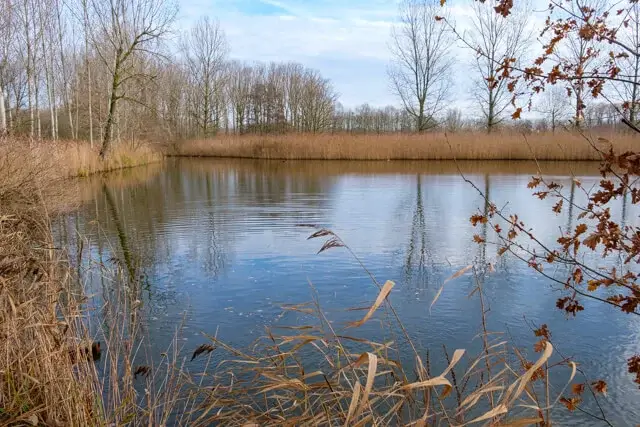Walking route
Roosenberg route.


Roosenberg route.
This walking route introduces you to the beautiful surroundings of Waasmunster. Discover the landscape along the Durme where wet lands, forests and heather alternate. Historical paths, an old railway bed, several castles and the Roosenberg Abbey make it a very varied walk.
Distance: 11 km.
Time: 2h30.
Grade: Easy.
Type: Circular.
Gps Track: Yes.
Route description: Yes.
Wheelchair: Not suitable.
Dog: Allowed on leach.
Height gain: Flat.
Trail: Paved and unpaved.
Marking: Red and Blue.
Hiking shoes recommended.
Blauwendael castle.
The walk starts in the park of Castle Blauwendael and takes you to the church of Waasmunster. After a little paved walk on the edge of the Moerasput to the Pontrave dike. On the dike you follow the bank of the Durme to the Durmemeersen. Here you leave the Durme and you walk very briefly through an SME zone and then explore the pine forests around De Vaag on a sandy path. You pass the castle Les Gobelets (private property) and you arrive at the Abbey Roosenberg. Here you leave the red marker and now follow the blue marker through a built-up area to an old railway bed. You follow the old bed and historic slow roads to the towpath next to the Durme. You now follow the Durme and pass the Rietsnijderij where there are some nice picnic benches. Just before the Durme Bridge you leave the towpath to go back in the direction of the church and castle Blauwendael.
Download PDF for route description and map.
POI 1 - Blauwendael castle.
In the 17th-century Blauwendael castle you can visit the local museum 't Sireentje, albeit only every 2nd Sunday of the month. The museum is dedicated to local history, folklore and ancient crafts.
No additional information.
POI 2 - Moerasput.
The Moerasput is an old meander of the Durme and consists of a small and a large pond surrounded by a reed collar and a willow thicket.
No additional information.
POI 3 - Durmemeersen.
In the meantime, the nature reserve includes freshwater marshes where the extremely rare spider-dotted flower has recently found a permanent place again. These rare freshwater salt marshes are also extremely important at European level. Two reed beds of several hectares, which are important for many endangered reed birds, also developed. At any time of year, the hay meadows that receive targeted nature management can be easily distinguished from the other intensively used agricultural plots at a glance. The reserve plots have more structure. The grazing blocks are never eaten bare and are also less grass green in color. A strip is not systematically cut along the field edges. Here, larger herbaceous plants such as musthistle, meadowsweet or large loosestrife can develop unhindered. Here and there even a reed collar arises.
No additional information.
POI 4 - Roosenberg abbey.
The current Roosenberg III abbey was built in 1975 in a timeless style, based on a concept by a Dutch Benedictine architect. Until recently, this abbey was the last remaining abbey of female contemplative religious in East Flanders.
No additional information.
POI 5 - Rietsnijderij.
The Rietsnijderij is a unique freshwater marsh along the Durmedijk. Striking is the bloom in the spring of the dotter flowers. Special marsh birds such as the bluethroat and the small reed warbler populate the meter-high reed collars.
No additional information.















































